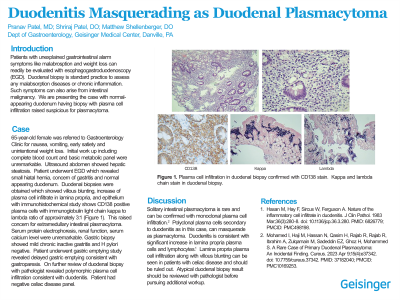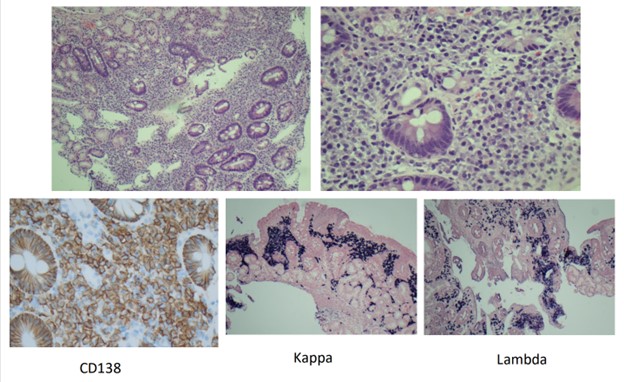Monday Poster Session
Category: Small Intestine
P3280 - Duodenitis Masquerading as Duodenal Plasmacytoma
Monday, October 28, 2024
10:30 AM - 4:00 PM ET
Location: Exhibit Hall E

.jpg)
Pranav D. Patel, MD
Geisinger Health System
Danville, PA
Presenting Author(s)
Pranav D. Patel, MD1, Shriraj S. Patel, DO2, Joshua Shellenberger, DO1
1Geisinger Health System, Danville, PA; 2Geisinger Medical Center, Danville, PA
Introduction: Patients with unexplained gastrointestinal alarm symptoms like malabrosption and weight loss can readily be evaluated with esophagogastroduodenoscopy (EGD). Duodenal biopsy is standard practice to assess any malabsorption diseases or chronic inflammation. Such symptoms can also arise from small intestinal malignancy. We are presenting the case with normal-appearing duodenum having biopsy with plasma cell infiltration raised suspicious for plasmacytoma.
Case Description/Methods: 65-year-old female was referred to Gastroenterology Clinic for nausea, vomiting, early satiety and unintentional weight loss. Initial work up including complete blood count and basic metabolic panel were unremarkable. Ultrasound abdomen showed hepatic steatosis. Patient underwent EGD which revealed small hiatal hernia, concern of gastritis and normal appearing duodenum. Duodenal biopsies were obtained which showed villous blunting, increase of plasma cell infiltrate in lamina propria, and epithelium with immunohistochemical study shows CD138 positive plasma cells with immunoglobulin light chain kappa to lambda ratio of approximately 3:1 (figure 1). This raised concern for extramedullary small intestinal plasmacytoma. Serum protein electrophoresis, renal function, serum calcium level were unremarkable. Gastric biopsy showed mild chronic inactive gastritis and H pylori negative. Patient underwent gastric emptying study revealed delayed gastric emptying consistent with gastroparesis. On further review of duodenal biopsy with pathologist revealed polymorphic plasma cell infiltration consistent with duodenitis. Patient had negative celiac disease panel.
Discussion: Solitary intestinal plasmacytoma is rare and can be confirmed with monoclonal plasma cell infiltration. Polyclonal plasma cells secondary to duodenitis as in this case, can masquerade as plasmacytoma. Duodenitis can have significant increase in lamina propria plasma cells and lymphocytes. Lamina propria plasma cell infiltration along with villous blunting can be seen in patients with celiac disease and should be ruled out. Gastroenterologists encounter atypical pathology results which often necessitate clinical correlation. Atypical duodenal biopsy result should be reviewed with pathologist before pursuing additional workup.

Disclosures:
Pranav D. Patel, MD1, Shriraj S. Patel, DO2, Joshua Shellenberger, DO1. P3280 - Duodenitis Masquerading as Duodenal Plasmacytoma, ACG 2024 Annual Scientific Meeting Abstracts. Philadelphia, PA: American College of Gastroenterology.
1Geisinger Health System, Danville, PA; 2Geisinger Medical Center, Danville, PA
Introduction: Patients with unexplained gastrointestinal alarm symptoms like malabrosption and weight loss can readily be evaluated with esophagogastroduodenoscopy (EGD). Duodenal biopsy is standard practice to assess any malabsorption diseases or chronic inflammation. Such symptoms can also arise from small intestinal malignancy. We are presenting the case with normal-appearing duodenum having biopsy with plasma cell infiltration raised suspicious for plasmacytoma.
Case Description/Methods: 65-year-old female was referred to Gastroenterology Clinic for nausea, vomiting, early satiety and unintentional weight loss. Initial work up including complete blood count and basic metabolic panel were unremarkable. Ultrasound abdomen showed hepatic steatosis. Patient underwent EGD which revealed small hiatal hernia, concern of gastritis and normal appearing duodenum. Duodenal biopsies were obtained which showed villous blunting, increase of plasma cell infiltrate in lamina propria, and epithelium with immunohistochemical study shows CD138 positive plasma cells with immunoglobulin light chain kappa to lambda ratio of approximately 3:1 (figure 1). This raised concern for extramedullary small intestinal plasmacytoma. Serum protein electrophoresis, renal function, serum calcium level were unremarkable. Gastric biopsy showed mild chronic inactive gastritis and H pylori negative. Patient underwent gastric emptying study revealed delayed gastric emptying consistent with gastroparesis. On further review of duodenal biopsy with pathologist revealed polymorphic plasma cell infiltration consistent with duodenitis. Patient had negative celiac disease panel.
Discussion: Solitary intestinal plasmacytoma is rare and can be confirmed with monoclonal plasma cell infiltration. Polyclonal plasma cells secondary to duodenitis as in this case, can masquerade as plasmacytoma. Duodenitis can have significant increase in lamina propria plasma cells and lymphocytes. Lamina propria plasma cell infiltration along with villous blunting can be seen in patients with celiac disease and should be ruled out. Gastroenterologists encounter atypical pathology results which often necessitate clinical correlation. Atypical duodenal biopsy result should be reviewed with pathologist before pursuing additional workup.

Figure: Figure 1: Plasma cell infiltration in duodenal biopsy confirmed with CD138 stain. Kappa and lambda chain stain in duodenal biopsy.
Disclosures:
Pranav Patel indicated no relevant financial relationships.
Shriraj Patel indicated no relevant financial relationships.
Joshua Shellenberger indicated no relevant financial relationships.
Pranav D. Patel, MD1, Shriraj S. Patel, DO2, Joshua Shellenberger, DO1. P3280 - Duodenitis Masquerading as Duodenal Plasmacytoma, ACG 2024 Annual Scientific Meeting Abstracts. Philadelphia, PA: American College of Gastroenterology.
